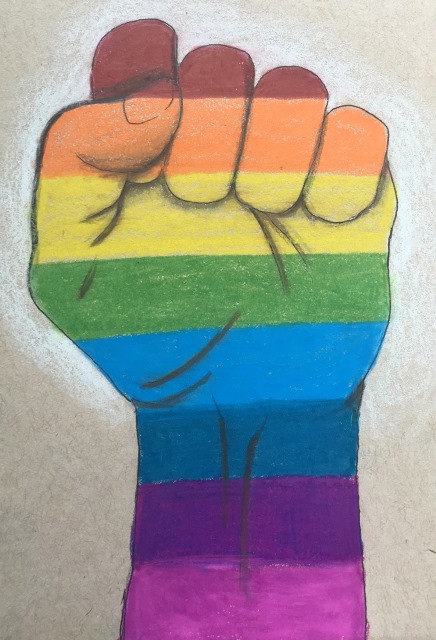The Fight for LGBTQ Rights is Not Over
School organizations like the Gay-Straight Alliance (GSA) provide a much needed safe space and support group for LGBTQ students.
May 10, 2016
After the Supreme Court’s historic decision to legalize gay marriage across the United States on June 26, 2015, many Americans believed that the fight for gay rights was over. However, they could not have been more wrong, as a multitude of issues still face the LGBTQ community, especially for transgender and gender nonconforming people.
Many people say that the battle for LGBTQ equality in the United States began on June 28, 1969, when a large group of protesters gathered at the Stonewall Inn, an underground gay bar in Greenwich Village, Manhattan. In the aftermath of those riots, gay and lesbian liberation groups worked to bring about recognition of the constant prejudices committed against gay people during those times. Finally, in 2004, Massachusetts legalized same-sex marriage, when the Massachusetts Supreme Judicial Court ruled that under the Massachusetts constitution, it was unconstitutional to restrict marriage to only opposite-sex couples. It took over a decade for the right to marry to reach the entire United States.
However, in 18 states, LGBTQ employees are not protected at the state level, which means that a worker can be fired on the basis of their sexual orientation or gender identity. Discrimination against the community does not only affect working adults; 40 percent of homeless youth identify as LGBTQ, and 68 percent of those youth report being forced out of their homes. In 2007, 86 percent of gay and lesbian students were verbally harassed, and 44 percent were physically harassed. The CDC states that “lesbian, gay, and bisexual youth were more than twice as likely to have attempted suicide as their heterosexual peers.” Greater than 50 percent of transgender youth will not reach the age of 20 without having at least one suicide attempt. None of the 53 transgender murders (most of which were committed against trans women of color) between 2013 and 2015 were described as hate crimes by the court.
So, with the state of gay and transgender rights in America as they are today, what can be done to help? First of all, the most basic idea that people need to realize is that these people who are being kicked out of their homes, murdered in the streets,or are committing suicide are exactly that: people. They are people who deserve as much love and respect as the rest of society. Parents have a responsibility to surround their children with an atmosphere of love and acceptance, not shame and unwelcomeness.
A strong support system is essential to the mental and physical well-being of LGBTQ people, especially youth. Parents and friends are crucial to that system, as they are the people that qr youth will turn to in times of trouble. Parents need to encourage an open relationship with their children, as that will make conversations about sexuality and gender much more comfortable. Another topic that will make these discussions more commonplace is education: education about sexual orientation and gender identity in health classes will help youth understand themselves, decrease harmful stigmas, and greatly accelerate the “normalization” process for talking about and dealing with these issues. Schools have the ability and responsibility to decrease bullying, and many are doing a wonderful job. However, anti-LGBTQ bullying still resides across the country, and it is up to schools and communities to combat it, as harassment and bullying are some of the largest, if not the largest, causes of the high suicide rates of LGBTQ youth.
As these people grow up and become adults, a new set of problems arise. For example, in 18 states, there are no statewide laws that prohibit employment discrimination against LGBTQ people. However, after the Supreme Court decision in June legalizied gay marriage, job discrimination was brought into the public view as the next issue to overcome. Since then, state laws have been put into place, and President Obama has signed an executive order that protects federal employees from discrimination based on sexual orientation and gender identity/expression.
However, the transgender community faces many challenges and acts of hate. Every three days, one transgender person is murdered worldwide. The number of transgender people being killed is at an all time high, and most of the victims are people of color. Shannon Minter, who works for the National Center for Lesbian Rights, said, “people who are marginalized both because of their race and being transgender, it’s like a double whammy.” It becomes even more terrifying to think about when you realize that 22% of transgender people in the National Transgender Discrimination Survey reported being harassed by the police. In 2015, 25 transgender people were murdered in the United States: Papi Edwards, Lamia Beard, Ty Underwood, Yazin Vash Payne, Taja DeJesus, Penny Proud, Bri Golec, Kristina Gomez Reinwald, Keyshia Blige, Vanessa Santillan, Mya Hall, London Chanel, Mercedes Williamson, Jasmine Collins, Ashton O’Hara, India Clarke, K.C. Haggard, Shade Schuler, Amber Monroe, Kandis Capri, Elisha Walker, Tamara Dominguez, Fernanda ‘Coty’ Olmos, Kiesha Jenkins, and Vicky Thompson. In order to bring about change, we must remember these names. Each of these 25 people had their own life, with their own families, friends, and legacies, cut short. We must never forget these names, as forgetting them would mean forgetting the hate and injustice that still exists for the transgender community.
Although marriage equality is the law of the land, there is still so much work to do to bring about equality for the LGBTQ community.



